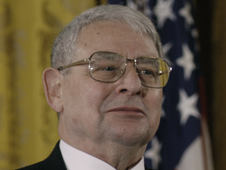Feature
Riccardo Giacconi to Receive National Inventors Hall of Fame's Lifetime Achievement Award
05.01.08
 Riccardo Giacconi
Riccardo GiacconiImage Courtesy of R. K. Morris (www.ryankmorris.com)
> Larger image Riccardo Giacconi, founding director of the Space Telescope Science Institute (STScI) will receive the 2008 Lifetime Achievement Award from the National Inventors Hall of Fame, Inc. on May 3 at the Hall's headquarters in Akron, Ohio. The annual Lifetime Achievement Award is given to an individual who has fostered innovation throughout his or her lifetime.
The Hall honors those who have demonstrated an extended commitment to progress in technical innovation and the protection of that innovation. Each year a new class of inventors is inducted into the Hall of Fame in recognition of their patented inventions that make human, social, and economic progress possible.
"It is a great honor to get this award," said Giacconi. "I am particularly pleased that I am to be included in such a restricted club which has among its members Edison and the Wright brothers. This is a humbling experience."
Giacconi is considered the "father of X-ray astronomy." He opened a new window on scientific understanding of the universe, from its evolution to its component black holes, neutron stars, galaxy clusters, and quasars. He is a co-recipient of the 2002 Nobel Prize in physics.
Born in Genoa, Italy in 1931, Giacconi received his Ph.D. in physics from the University of Milan in 1954.
Giacconi led the group of scientists at American Science and Engineering, Inc. in Cambridge, Mass. that was the first to make extrasolar observations in the 1960s. In 1970 he conceived of and led the implementation of UHURU, the first orbiting X-ray observatory which provided the first X-ray map of the heavens and identified the diffuse X-ray background.
Giacconi joined the faculty of Harvard University in 1973 and became an Associate Director for the Center for Astrophysics, High Energy Astrophysics Division. He served as principal investigator during the concept, design, and fabrication of the Einstein Observatory.
In 1976, he initiated the study and design of a large X-ray telescope, then known as the Advanced X-ray Astrophysics Facility. The telescope was renamed the Chandra X-Ray Observatory in 1998.
He was appointed by the Association of Universities for Research in Astronomy, Inc. (AURA), as the first director of STScI in 1981. Under his leadership, STScI developed the expertise and capabilities to direct the science mission for NASA's orbiting Hubble Space Telescope.
From 1981 to 1997, Giacconi was a professor in physics and astronomy at the Johns Hopkins University (JHU) in Baltimore. Upon leaving STScI in 1993, he began a seven- year appointment as Director General of the European Southern Observatory (ESO) in Garching, Germany. In 1999 he was appointed president of Associated Universities, Inc. (AUI), the consortium that co-administers the National Radio Astronomy Observatory with the National Science Foundation. Giacconi retired from AUI and was named University Professor at JHU in 2004.
The Hubble Space Telescope is a project of international cooperation between NASA and the European Space Agency (ESA) and is managed by NASA's Goddard Space Flight Center (GSFC) in Greenbelt, Md. The Space Telescope Science Institute (STScI) conducts Hubble science operations. The institute is operated for NASA by the Association of Universities for Research in Astronomy, Inc., Washington, DC.
Space Telescope Science Institute, Baltimore, Md.
410-338-4707
gundy@stsci.edu